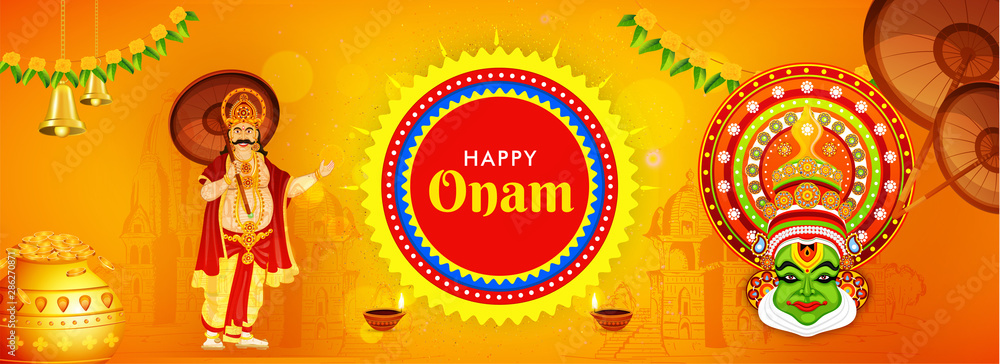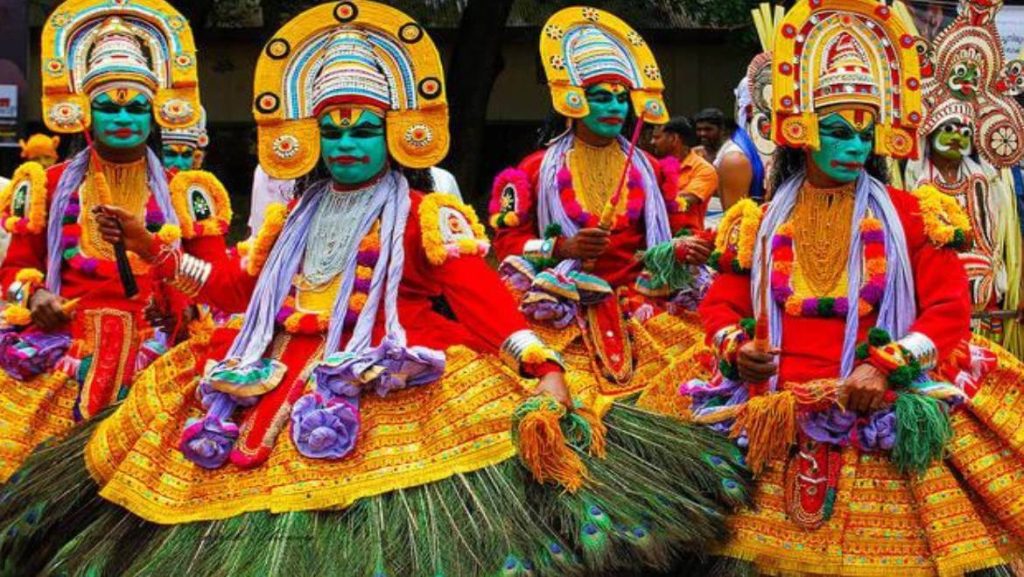- Private car and driver in Delhi / India
- +91-8447445445
- info@discoverindiabycar.com sugar.ankit@yahoo.com
 +91-9818434712
+91-9818434712
Onam Festival
Onam is a traditional Hindu festival celebrated in Kerala that honours the rice harvest. The celebration has special meaning in Indian culture, of which there are two that are more prevalent.

Onam honours King Mahabali and Vamana.
Onam is celebrated in Kerala as a commemoration of the good governance that flourished there under the rule of the legendary daitya monarch Mahabali, according to Hindu mythology. The devas and gods allegedly plotted to depose Mahabali because they were jealous of his fame and power. Vamana, a little Brahmin, was sent to Earth where he crushed Mahabali to patala (netherworld). Vamana begged the generous Mahabali for three feet of land. Vamana’s plea was granted by Mahabali since it is blasphemous to withhold gifts to Brahmins.
Vamana could not fit his third foot into his first two feet after measuring the entire cosmos. Mahabali offered his own head at the position of his third feet in order to grant the wish. Yet after witnessing Mahabali’s generosity, Vishnu agreed to the king’s lone request to visit his realm and subjects once a year. Onam is a holiday celebrated annually in Kerala to honour Mahabali’s return to his homeland.
History and Importance of Onam
Onam is a harvest festival observed in Kerala. In Kerala, where the demon king once reigned, it also heralds the return of King Mahabali/Maveli. Legend has it that the good-hearted King Mahabali overcame the Gods and established rule over all three planets.
The Malayalam calendar’s first month, Chingam, is when Kerala celebrates the holiday known as Onam. The culmination of the ten-day celebrations honouring the Malayalam New Year is Thiruvonam. The ten days are referred to by their respective names: Atham, Chithira, Chodhi, Vishakam, Anizham, Thriketa, Moolam, Pooradam, Uthradam, and Thiruvonam. The first and last day are extremely important in Kerala and to Malayalee people worldwide.At the Vamanamoorthy Thrikkakara temple, celebrations for the Atham day begin (Kochi). With the raising of the festival flag, this Vishnu temple is regarded as the epicentre of Onam and the residence of Mahabali. It is customary to hold colourful parades that feature floats and tableaus that represent many aspects of Keralan culture.

Other festivals and activities are held on other days, such as boat races, cultural performances, sporting competitions, dancing competitions, martial arts, floral Rangoli-pookkalam, prayers, shopping, donating time or food to charities, and gathering with family for feasts. Both men and women dress traditionally. On this day, it is especially common to wear the Kerala or Kasavu sari.
Athachamayam
Every year, the festival of Onam begins with the Athachamayam parade. Atthachamayam, also known as Thripunithura Athachamayam, is a large procession that kicks off the Onam celebrations across the state at Thrippunithura near Kochi. A painted elephant moving through the parade, drumming and other music, folk art, floats, and colourfully attired people wearing masks are all part of the event. The Kochi king used to lead a large military procession from his palace to the Thrikkakara temple in Kerala’s past to meet and greet his subjects while dressed in full ceremonial clothes. This is a state-supported event in modern times.
Rhythm and dance
At Onam, Thiruvathira Kali performs a dance. Traditional dance styles include Thumbi Thullal, Onam Kali, Thiruvathira, Kummattikali, Pulikali, and others. Women perform the Thiruvathira Kali dance in a circle around a lamp. Kummattikali is a dance that uses vibrant masks. A procession of caparisoned elephants and Kummatikali dancers is one of the events in Thrissur. The vibrant Kummattikali is performed door to door by the masked dancers. Onam Kali is a type of dance in which participants form concentric circles around a pole, tree, or light and then perform dances and sing songs from the Ramayana and other epics.
Boat race in Vallamkali
The Vallamkali (also known as the snake boat race) is another occasion connected to Onam. The Aranmula Uthrattadhi Boat Race and the Nehru Trophy Boat Race are well-known competitions. Huge, snake-shaped boats are rowed by numerous oarsmen. To see and support the snake boat race through the water, men and women travel from far and wide. The Pampa River, which is revered and is regarded Kerala’s version of the Ganges River, is where this ceremony is particularly prominent.
Food
The traditional vegetarian supper eaten on a banana leaf during Onam is called Onam Sadya Sadya. The final day of the Onam harvest festival is honoured by a special lunch that includes rice and a dessert. Another essential component of Onam is the Onam sadya (feast), which practically every Keralite either hosts or attends. The Onasadya is usually prepared with seasonal vegetables like yam, cucumber, ash gourd, and others to reflect the spirit of the season.

The nine-course meal is served on plantain leaves and may include more than two dozen dishes, such as Chips (especially banana chips), Sharkaraveratti (fried banana pieces coated in jaggery), Pappadam, various vegetable and soup dishes like Injipuli (also known as PuliInji), Thoran, Mezhukkupuratti, Kaalan, Olan, Avial, Sambhar, Dal served with a small amount of ghee, Erisheri, Molos The meal concludes with a sequence of desserts called Payasam, which can be consumed alone or combined with ripe fruit. Payasam is a sweet dish comprised of milk, sugar, jaggery, and other traditional Indian savouries.
Floral Rangoli
A custom during Onam is to create floral Rangoli.During Onam, the Thrikkakara Appan Onathappan idol (a representation of Vamana) is found inside Pookalam. The floral Rangoli, also referred to as Onapookkalam, Athapookkalam, or simply Pookkalam,is made from the gathered flowers. Various flower species of various hues are pinched up into tiny pieces to design and decorate patterns on the floor, particularly at entrances and temple premises like a flower mat. In the centre or on the edges, lamps are placed. It is a piece of religious art that girls and women often create together, and they do so with a deft touch and their own unique creative sense of tone and blending.
On Atham day, the customary practise of placing pookkalam (floral Rangoli) begins. Athapoo is the name of the pookkalam on this day, and it is a rather compact size. Each day of the Onam celebration sees a gradual increase in the size of the pookkalam. On Atham, only yellow flowers will be used, and the design will only have one circular layer. On this day, statues or representations of Mahabali and Vamana are also placed at the entrance to each home.








